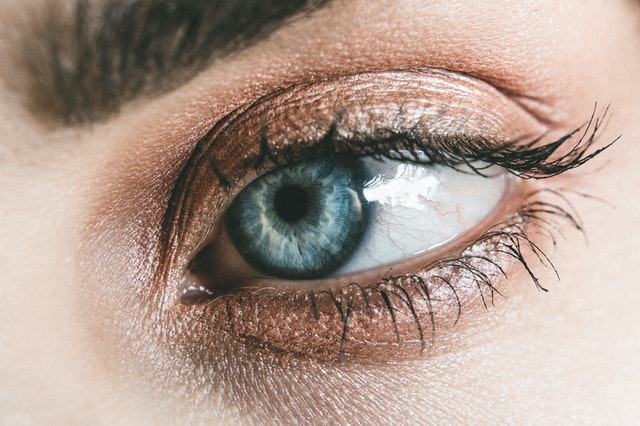
Having pink, red, yellow, blue, or spotty sclerae could be a sign of an underlying condition. Photo by Lisa on Pexels.
Rose-Colored Lenses
Spending a lot of time in front of a Zoom camera over the last year and a half has made me aware of a lot more things about my appearance, some of them easier to accept than others. For example, I discovered that I like my eyebrow shape, that my eyes are more green than blue, and that I am actually prettiest when I smile.
All things considered, these are fairly inoffensive discoveries for a facecam-veteran. But one new fixation has had me disparaging in front of the mirror over the last few months. Silly, I know, but I can’t get it out of my head.
The whites of my eyes? Yeah, they’re not white. They’re light pink. Pink! Have you ever heard any respectable person say “the pinks of my eyes”? No! Of course not!
Desperate for a solution to my pink eye problem (not the virus), I found out that the ‘whites’ of our eyes—medically referred to as the sclera (singular) or sclerae (plural)—and the various tints they take on can actually tell us a lot about our health. Here are the findings that the internet has availed me:
If the whites of your eyes are yellow…
Yellow whites are usually a sign of a liver, pancreas, or gallbladder problem. For example, if your liver is having issues filtering as it should, yellow sclerae could be a sign of jaundice, a condition where waste material called bilirubin builds up in excess in your blood. Having high amounts of bilirubin not only causes the sclerae to turn yellow, but it can lead to fever, vomiting, seizures, and brain damage, among other serious things.
Jaundice may also be a secondary symptom attached to a hepatitis, cirrhosis, cancer, malaria, anemia, gallstones, or liver infection diagnosis, so it’s important that if your eyes are turning yellow to contact a doctor as soon as possible.
If the whites of your eyes are gray or blue…
Having blue sclerae, or more accurately, sclerae that appear blue, indicates that there is an issue with your sclerae themselves. Imagine that your eye is a Kinder Surprise egg. Your sclera, or the white of your eye, is the chocolate coating, while the next layer down, your uvea, is the plastic egg. Now, if you lit a match and held it to the chocolate and started to melt it away, you would start to see the egg’s plastic through the chocolate coating, right? That’s exactly what’s happening when the whites of your eyes look blue. Somehow, something is causing the connective collagen fibers of your sclerae to thin, revealing the blue hue of the veins in your eyes’ underlayers.
Blue sclerae can be caused by a plethora of different syndromes such as brittle cornea syndrome, Ehlers-Danlos, certain kinds of anemia, and many more. However, illness is not the only culprit. For instance, it’s common that the whites of infants’ eyes will have a blue tint simply because their collagen coatings haven’t finished developing yet, leaving them thin and transparent. Over time, they will thicken and the blue tint will go away on its own.
If the whites of your eyes are brown (or have brown spots)…
Despite looking alarming, an errant brown spot or section in the eye is normal. Under most circumstances, the dark patch is a stray bit of pigment like a freckle or a mole, only occurring on the surface tissue of the eye rather than the surface of the skin.
While these pigmented spots are normal, it’s good to have them regularly monitored by an eye doctor. If any spots spread, shift, darken, or otherwise change, it could be a sign of the pigment becoming cancerous. So keep an eye on it!
If the whites of your eyes are red…
If you’re seeing red— red in a literal sense, not a metaphorical one— then it’s a sign of injury. The most common cause of blood-red sclerae is burst blood vessels, otherwise known as subconjunctival hemorrhages, which usually occur as a result of trauma. For example, if you get a nasty respiratory infection and cough hard for a few days, you may notice when you look at yourself in the mirror that a bit of blood has seeped into your eye. While trauma has caused the initial break, it’s uncommon that a hemorrhage like this will require treatment. Over time, the blood will be resorbed and you will continue seeing as normal. Despite looking scary, it’s usually not a big deal. If a sneeze, cough, strain, or bit of rubbing caused it, it’s nothing to lose sleep over.
However, if these hemorrhages happen frequently, come with discomfort, vision changes, or happen because of a foreign object entering the eye, it’s crucial to seek help from a medical professional. It may require changing around medications or removing trapped debris or further screenings to rule out more serious conditions like uveitis or cancer.
If the whites of your eyes are pink…
There are lists upon lists of all the possible reasons why the whites of your eyes take on a pink tinge. Pinkness by itself isn’t necessarily any more serious than regular irritation. Eyes are incredibly sensitive organs that an enormous fraction of us put to work for long hours without breaks. Chances are that having a pair of blushing blinkers is indicative of a regular lack of sleep, overexposure to sunlight and pollution, seasonal allergies, screen time, dryness, etc.
It’s usually only when pinkness is paired with something else like swelling, burning, itching, watering, blurring, the development of growths or protrusions, stickiness/discharge, or loss of vision that it’s considered sinister. Doctors can help determine whether a specific combination of symptoms is anything dangerous.
So, in my case, I’m at a loss. My pink whites are painless, unswollen, protected from blue light, and seeing clearly. I’m great at whipping up tears, wearing proper eye protection, and getting enough sleep. I don’t use contacts, drink, smoke, swim, or have allergies.
The conclusion I’ve come to is that the pink I’m seeing has less to do with any potential ailment and is simply a typical part of having eyes. Every eye is veined with small, red vessels that deliver blood, oxygen, and nutrients to its different structures. Naturally, those vessels dilate and constrict based on day-to-day stimuli. For whatever reason, my combination of genes, age, health, and exposure make my eyes’ veins more prominent than I would like, hence the pink appearance.
Can anything be done?
There are treatments available for people like me who are fed up with having pink, bleary eyes. Obviously, the safest choice is to meet with an eye doctor to openly discuss any concerns. After all, just because having pink sclerae is a common thing doesn’t mean that a doctor won’t notice something under their lights and lenses. Only an eye specialist will have the knowledge and equipment to give a sound diagnosis and appropriate treatment.
However, consulting with a doctor isn’t the only option. There are over-the-counter remedies for a bit of everyday pink. If you’re interested, here’s a fantastic video on OTC eyedrops, which ones are the safest to use, and how often they should be used.
Furthermore, here are a few tips to reduce eye irritation naturally.
- Make a concerted effort to blink often. Statistically, humans blink 66% less when looking at a screen than when not looking at a screen. It’s time to fight screen hypnosis and work to keep our eyes wet and functional.
- Get at least eight hours of sleep. Not only is sleep essential for eye health, but being sleep deprived is neurologically similar to being tipsy, so you put yourself and others at risk without enough shut-eye.
- Take a short eye break every hour to recalibrate your eyes. You can perform a quick eye “reset” by looking at a point at least 20 ft. away and blinking hard to generate fresh tears. Scientists speculate that the mechanics of the human eye make it best suited for long distances–looking at things up close for too long puts a lot of strain on it and its and surrounding muscles. Hearken back the time of our plain-dwelling ancestors and let your eyes rest by doing the kind of seeing they were designed to do. Stand back, pick a far-off point, and blink hard for a visual reset! It’s not ancient history.
- Keep eyes out of direct airflow, like the airflow generated by a fan or heater. This can evaporate the tear barrier protecting the surface of your eye and increase irritation.
- Practice proper eye hygiene. Regardless of your makeup habits, it’s important to clean your eyelashes and eyelids often to prevent the buildup of oils and dead skin. Any blockages, no matter where they are, can make the whites of your eyes veiny and pink. And of course, never, ever sleep with your contacts in.
- Avoid wearing makeup on your waterlines. On, above, and below your waterlines are small, sensitive glands called meibomian glands. Meibomian glands secrete lipids into your tears to keep them from evaporating too quickly. If you block these glands with makeup (or anything else), you will deprive your eyes the of nutrients they need to work their best. In fact, if you can go a day or two out of the week without wearing any makeup on your eyes at all, you might find that your pinkness clears up on its own, leaving you with brilliantly white whites.
- Be wary of eye modifications. Eyelash extensions, eyeball or eyelid tattoos, colored contacts, eyelid piercings, jewelry designed to be embedded into the corneas, and eyelid piercings are all suspect. These kinds of eye modifications, while trendy, are not always safe or sterile and could result in impaired vision or eye loss, much less irritation and pinkness.
Agents
We hope that this information on sclerae color was useful to you. Or at the very least educational!
Empower Brokerage is dedicated to helping you make informed decisions about your health and finances. Whether it’s through webinar training, one-on-one calls, seminars, or marketing plans, we want you to be successful!
Give us a call at 888-539-1633 or leave a comment below if you have any questions.
Quick links:
Born in and raised in Maryland, educated in Utah, and new to Texas, Cristin is a purveyor of stories from all widths and walks of life. With a bachelor’s degree in filmmaking and a staunch passion for literature, she aspires to give digital spaces a uniquely human touch.




